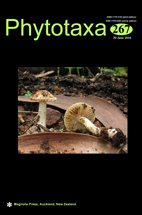Abstract
Although many species of Pleurotus are commonly known to be important edible mushrooms, the species delimitation of the genus is often controversial due to phenotypic plasticity and morphological stasis. In the present paper, Pleurotus placentodes, a conspicuous species originally described from Sikkim by M.J. Berkeley in 1852 and so far known only from the type collection, is documented based on specimens recently gathered in the eastern Himalayas and Hengduan Mountains, southwestern China. The morphological and molecular phylogenetic data indicate that this species is an independent taxon, and accordingly the previously proposed synonym of Pleurotus djamor is rejected. Pleurotus placentodes differs from the majority of other related species assigned to Pleurotus by the ellipsoid to subovoid basidiospores with a lower ratio of length/width and the geographical distribution in the subalpine habitat of the Himalayan Mountains.

